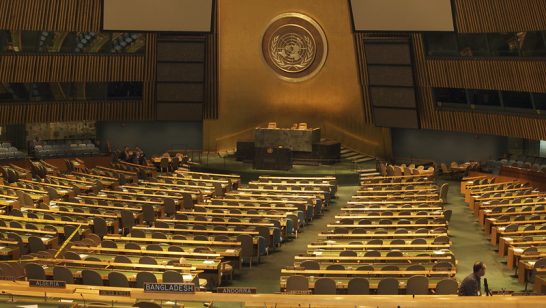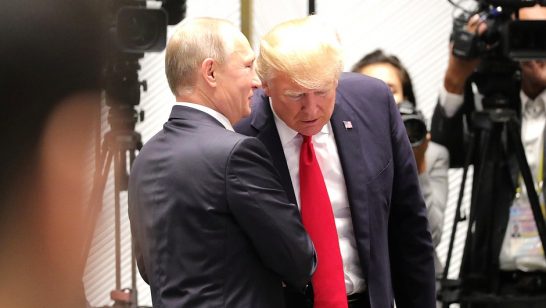
The year 2019 saw the continued collapse of nuclear and conventional arms control between Russia and the West. In the near term, there will be few domestic incentives to pursue new agreements, restrain the development of military technologies, and engage in principled diplomacy. Arms control’s best hope, for the time being, is to preserve US-Russian strategic nuclear parity and cooperative transparency.
At the end of the Cold War, there were hopes that arms control could contribute to the emergence of a new regional security order in the Euro-Atlantic with its cooperative transparency potentially enabling the transformation of political-military relations between Russia and the West away from nuclear deterrence. But instead of a transformation, the 2020s are set to kick off with continued bitterness about who broke what first.
Over the last two decades, the US and Russia have preferred to scuttle arms control agreements that were perceived as inhibiting technological developments or proved challenging to reform. Frustrated by what Moscow perceived as a failure to achieve progress on Euro-Atlantic security and by the US development of European missile defence after Washington’s withdrawal from the Anti-Ballistic Missile (ABM)Treaty in 2002, Russia suspended its implementation of the Conventional Forces in Europe (CFE) Treaty in 2007. It also reportedly began to violate the first end-of-the-Cold-War nuclear arms control agreement, the 1987 Intermediate-Range Nuclear Forces (INF) Treaty. Successful New START negotiations in 2009 were soon eclipsed by the regional stakeholders’ inability to agree on missile defence cooperation or negotiate a follow-on agreement that would include non-strategic nuclear weapons. These disagreements, as well as Russia’s annexation of Crimea in 2014 and its actions in Ukraine, served as the backdrop for the breakdown of the INF Treaty in 2019.
Despite many creative recommendations from civil society and senior statesmen on regional security, proposals on how to “rescue” the INF Treaty and new ideas for operational arms control in the Euro-Atlantic have not found a receptive audience. There is also now the possibility that the United States will withdraw from the Open Skies Treaty, thus potentially disrupting an inexpensive transparency mechanism that enables Washington and its regional allies and partners to cooperatively monitor, image, and share data on Russian military formations and facilities. This development would also be regrettable because Open Skies carries important symbolism—its overflights facilitate Western cooperative transparency with a country that has feared others’ aerial reconnaissance over its territory since World War II. This Russian apprehension is one of the chief reasons it took ten years for the Open Skies to enter into force in 2002.
So far, only strategic arms control has remained unbroken. The New START Treaty maintains US-Russian strategic nuclear parity levels and provides verification and cooperative transparency. As the lead US negotiator of the Treaty has argued, New START provides the United States “a stable environment in which to modernize” its nuclear weapons. Russian leaders, in turn, view New START as a key element of strategic stability and an arrangement that doesn’t carry the Cold War baggage of the INF Treaty. However, there is a nontrivial chance that the United States will decline to extend New START by 2021 and that Washington and Moscow will prove unable to negotiate a follow-on accord.
Arms control in the 2020s will face headwinds. Placing restraints on the development or limits on the deployment of newly emerging strategic offensive and defensive technologies is bound to prove difficult without a vision, or even an acknowledgement of a relationship between offence and defence. In the absence of domestic incentives for arms control, such as grassroots interest in nuclear reductions or economic circumstances that force tough choices across defense budgets, arms control is unlikely to be politically advantageous.
Worse, concerns about the other’s superiority and one’s own potential vulnerability may exert political pressures on domestic procurement and enable the pursuit of technological solutions to what are ultimately political problems in relations between states. And, after the INF Treaty’s breakdown over noncompliance allegations, picking up the pieces and rebuilding domestic consensus on the importance of arms control in national security will be essential. Negotiations will require quiet and principled engagement that stays out of the headlines—a near impossible feat in the days of social media diplomacy.
In any future negotiations with Russia, the United States must take care to manage Russia’s concern that Washington’s chief arms control goal is to weaken or disarm Moscow. Russia does not want deeper cuts to its strategic nuclear forces, but it is keenly interested in limits to US missile defences and strategic conventional capabilities. In turn, Russia’s development of capable ICBMs, including the Sarmat, provides it with a hedge if New START is not extended. Russia’s breakout capacity if both sides abandon New START should be incentive enough to engage and preserve strategic nuclear parity through a treaty arrangement, even as Washington builds its understanding of Moscow’s new nuclear and conventional capabilities.
In this regard, Moscow’s concern about US missile defence has contributed to a pursuit of “exotic” systems that buttress its seconds strike as well as conventional capabilities that could target an opponent’s missile defence system elements, including in space, early in a conflict. To be sure, Russia’s non-strategic nuclear weapons are of concern. However, Russia’s burgeoning conventional long-range strike and non-kinetic capabilities also allow it to achieve strategic effects, including over great distances, by precisely targeting nodes of an opponent’s critical military and civilian infrastructure before ever crossing the nuclear threshold. Limiting these new Russian capabilities will not be easy without a clear understanding and discussion between both sides that explores the potential advantages of mutual constraints.
Extension of New START is also important in order to preserve cooperative transparency and predictability that results from the flow of US-Russian baseline data, on-site inspections, and noninterference with national technical means. Access, once taken away, will be difficult to recover and certain types of data may prove impossible to reconstruct. If politicized, the issue of on-site inspections may once again come to plague and paralyze arms control negotiations between Washington and Moscow, much like it did during the Cold War. The easiest way to avoid that predicament is to, at the very least, retain the present level of bilateral cooperative transparency.
The adversarial nature of US-Russian relations and ongoing rapid change in military technologies are two trends that will almost certainly persist throughout the coming decade. Because of that, perhaps the biggest challenge for national security policymakers will be to avoid a situation where Washington and Moscow come to share what Thomas Schelling once referred to as the “reciprocal fear of a surprise attack.” While arms control in the 2020s may be a daunting proposition, all other options seem infinitely worse.
Dr Fink is a research analyst at CNA and a research associate at the Center for International and Security Studies at Maryland. All opinions expressed here are her own.
The opinions articulated above represent the views of the author and do not necessarily reflect the position of the European Leadership Network (ELN) or any of the ELN’s members. The ELN’s aim is to encourage debates that will help develop Europe’s capacity to address pressing foreign, defence, and security challenges.
Image: Flickr, Official US Navy



